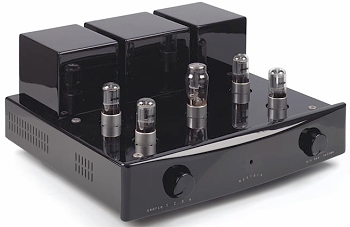Introduction
Having lived through the golden age of tubes, then the move to solid state, it is wonderful to see tubes re-emerge in the world of audio. This is coincidental with vinyl popping its head up and taking a strong foothold in sales again, but that is a subject for another day.
Tubes, by their nature, require big power supplies, so I am not sure if we could call any tube component “entry-level”, although there are some (relatively) inexpensive tube headphone amplifiers.
As luck would have it, there are now plenty of brands and models to choose from.
Specifications
- Design: Stereo Tube Preamplifier
- Maximum Output: 19 Volts RMS
- Tube Compliment: Four 6SN7, One 5AR4
- MFR: 8 Hz – 200 kHz
- THD+N: 0.12% at 1 Volt Output
- Input Impedance: 150 kOhms
- Output Impedance: 592 Ohms
- Inputs: Four RCA Pairs
- Outputs: One RCA Pair
- Dimensions: 7.9″ H x 16.9″ W x 16.4″ D
- Weight: 45 Pounds
- MSRP: $2,195 USA
- Mystère USA
Mystère is a high-performance line of tube components manufacturerd by Durob Audio, located in The Netherlands. They also produce the PrimaLuna line, some of which we have reviewed at Secrets.
In June, 2010, we reviewed the Mystère pa21 power amplifier, which delivers 2 x 55 watts via KT88 output tubes.
The matching preamplifier, the Mystère ca21, is reviewed here.
The Design
The ca21 uses dual triodes (6SN7) in its single gain stage design, and is, therefore, signal inverting (you will need to reverse the speaker connections if your power amplifier does not invert the signal). It also uses a tube (5AR4) as the full-wave rectifier in its power supply. So, this is an all-tube product, like its brother, the pa21.
The circuit of the ca21 uses a variation of a cathode follower, called the White cathode follower.
Here is a schematic of a generic cathode follower, capacitor-coupled (in other variations, there is a resistor at the input rather than a capacitor). Its name is derived from the fact that the cathode is connected to the output instead of the anode (plate), so the cathode follows the input. The red arrows outline the signal path. The main advantage of this type of circuit is that it produces a low output impedance.
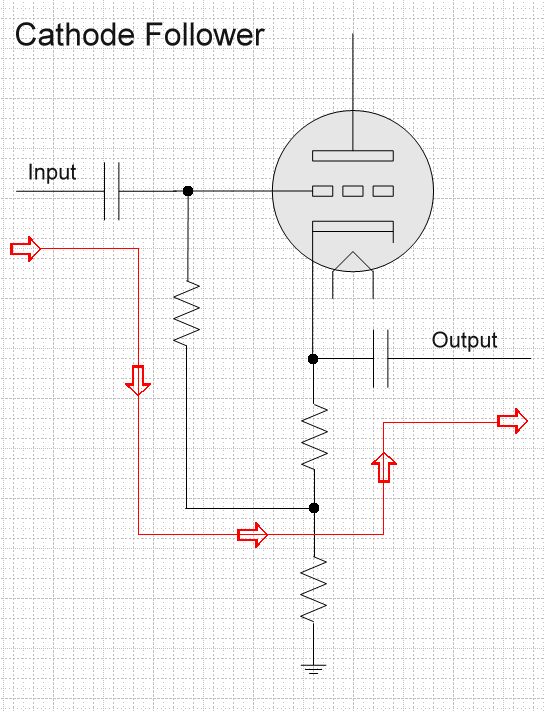
In the White cathode follower, there is a second tube (it could be the second triode in a dual triode, which is the case for the 6SN7). While a cathode follower does not have any gain, the White cathode follower does provide additional idle voltage so the stage can be biased more into Class A.
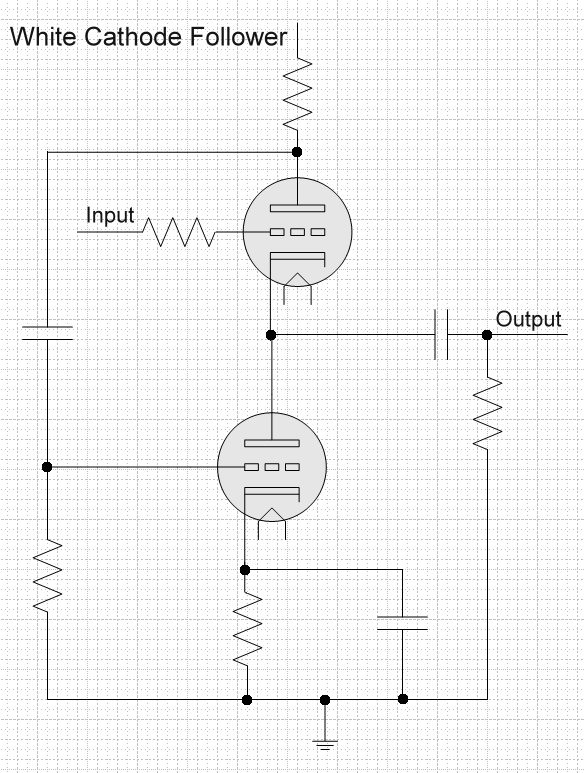
Here is a pin-out schematic for the 6SN7 (first diagram) and the 5AR4 (second diagram). The 5AR4 is a twin-diode.
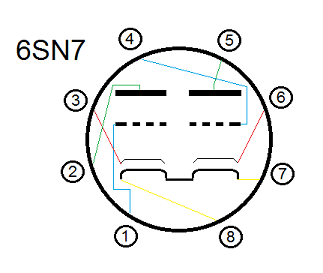
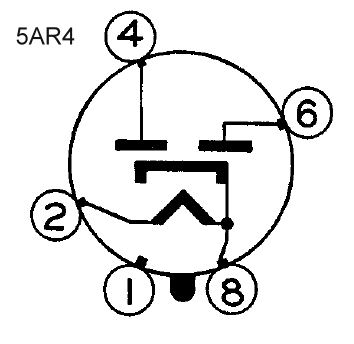
Shown below is the basic schematic for the Mystère preamplifiers. Only one channel is illustrated here. It is a variation of the White cathode follower, and is called a Series Regulated Push-Pull configuration, or SRPP.
The bottom line is that the ca21 only has a single gain stage, which is beneficial, because it means less things in the signal path. In fact, there is only one capacitor in the path, at the output (this prevents DC from getting into the signal that is sent to the power amplifiers). The preamp circuit does not use any negative feedback.
![]()
From the factory, I received the following description of the circuit:
“The input circuit is a non-decoupled SRPP, direct coupled to the output cathode follower with a constant current source in the cathode, which is a simplified variation of the White cathode follower, providing an output impedance of just below 600 Ohms but at the same time without the White’s relatively poor input overload voltage rating. Our specific circuit can cope with much higher signal voltages, making it more linear, hence less distortion, and considerably more resolution and transparency, because no feedback is employed. The only “feedback” is local cathode degeneration, not decoupled, to maintain high linearity. Decoupling is only done when lots of gain is required, and involves a bypass capacitor on the cathode resistor.”
The ca21 is very heavy, at 45 pounds, due to the power supply transformer, but also because of two massive power supply inductors that are encased on the top of the chassis next to the main transformer.
With power supplies, they can simply have a capacitor filter at the output (usually, there are several), which optimizes the power supply for high voltage deivery, or it can also have chokes (inductors), which provide steadier current under varying load conditions.
First, here is a schematic of a full-wave rectifier with capacitor filter.
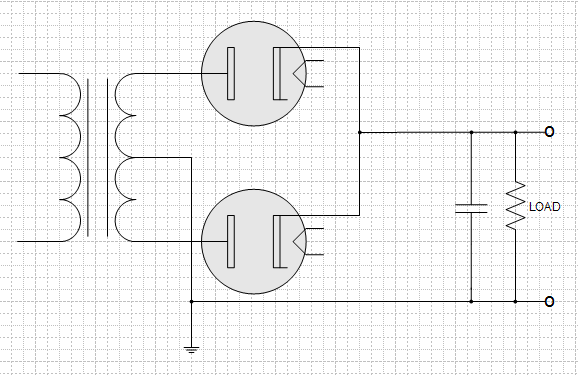
Below is the same power supply, but with a choke added to the circuit.
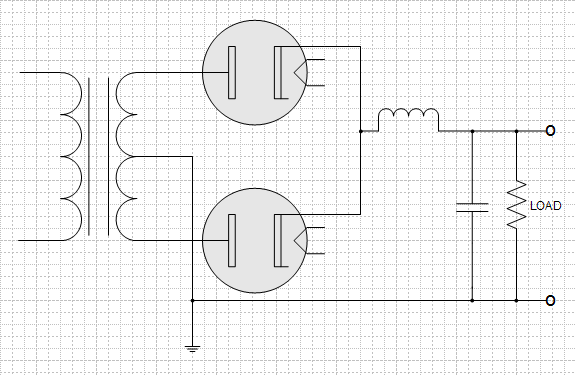
Here is the power supply with two chokes, as is the case for the ca21.
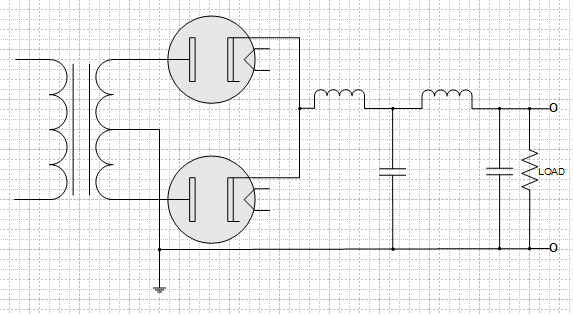
The front panel has the input selector, which lets you choose from among four input pairs of RCA jacks on the rear panel. On the right is a stepped (24 steps, via precision resistors) volume control, shown below. Outputs consist of a single pair of RCA jacks. All the jacks are gold-plated, and good build quality.
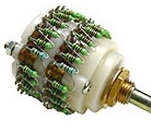
In Use
I listened to the ca21 with a McIntosh MCD500 SACD player, OPPO BDP-83SE/NuForce universal player, VPI-HRX turntable, Manley Labs Steelhead phono preamplifier, Mystère pa21 power amplifier, McIntosh MC1201 monoblock power amplifiers, and Carver Amazing Mark IV ribbon speakers. Cables were Emotiva and Legenburg.
The ca21/pa21 pairing produced a lush, sweet, smooth – yet still detailed – sound that is typical of high quality all-tube setups. Voices are silky, rather than overyly sibilant, which is something I appreciate. The music flow, like gentle rapids on a river. You can just sit back, close your eyes, and enjoy the sensations as well as the music. The pa21 only has 55 watts output, so I stayed with my favorite chamber music SACDs here. For larger venues, so to speak, such as full orchestral music, or just some jazz quartets that I wanted to play at floor-stomping volume, I connected the ca21 to my MC1201s, which will deliver several thousand watts peak. As I have said before, my favorite combination is a triode tube preamplifier with large solid state power amplifiers.

Shown below is a photo of my lab, where I have a full drum set that I often play along with my collection of classic jazz LPs. Normally, when I am doing some critical listening, the drum set is disassembled and set against the rear wall near the door. All of the drums and cymbals are on four stands connected together with chrome steel tubing and three clamps, so to assemble or disassemble the kit, it is only necessary to loosen the clamps, and move the four stands with drums and cymbals still attached, into the room or back against the wall.
I can’t impart upon you how much fun this is. And, I did it with the ca21/pa21 pair, as well as the ca21/McIntosh MC1201 pair. The snare and main cymbals are acoustic, while the toms and crash cymbals are electronic samples (I recorded them from my cymbal collection) which are triggered via a MIDI controller, through the computer, using BFD2 drum software, output to a second preamp, power amp, speaker system. I could not get the loudness I wanted with the pa21, but at its available volume, the quality of reproduction was marvelous.
![]()
On the Bench
All distortion measurements were made within an 80 kHz bandwidth.
At 1 kHz and 2 volts output, distortion was less than 0.03%, primarily 2nd order. At 5 volts output, distortion rose to 0.068%, again, primarily 2nd order.
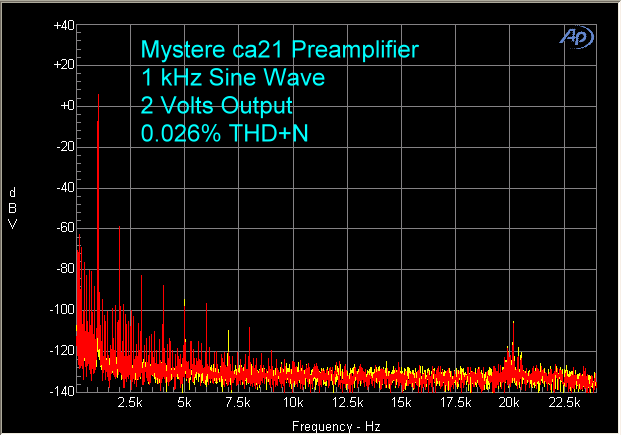

Using a combination of 19 kHz and 20 kHz test sine waves, the B-A peak at 1 kHz was 65 dB below the fundamentals at 2 volts output, and 58 dB below at 5 volts output.
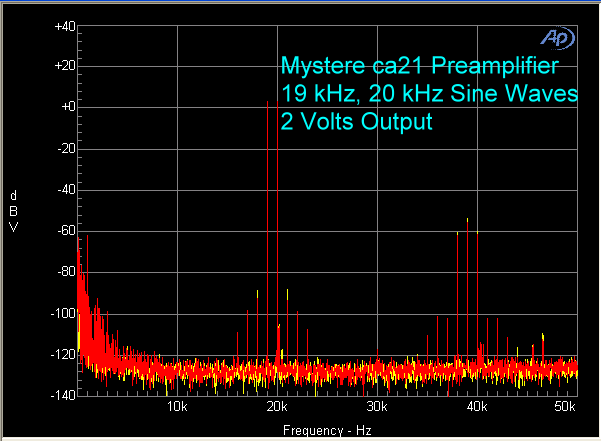

IMD was a very reasonable 0.11% at 2 volts output, rising to 0.27% at 5 volts output.
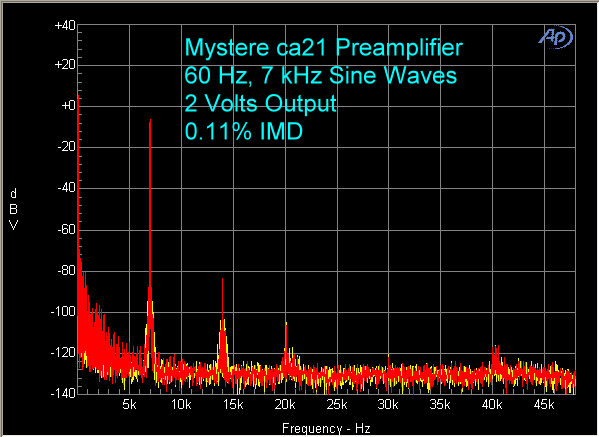
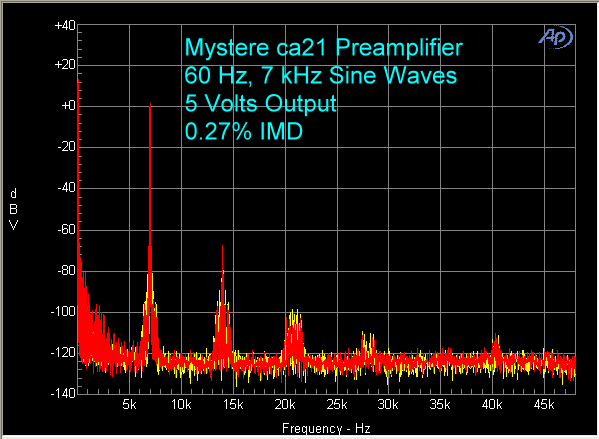
The THD+N vs. Frequency graph showed a rise beginning at about 2 kHz, but stayed below 0.5% all the way out to 50 kHz.
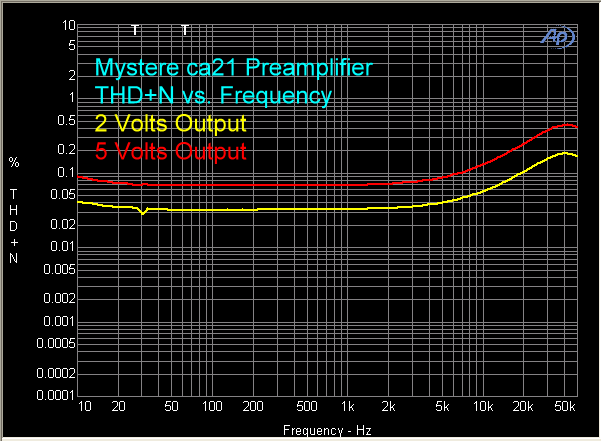
Distortion vs. Output Voltage illustrates maximum performance at 1 volt output. Clipping (1% THD+N) occurred at 21 volts, which is near the specification of 19 volts.
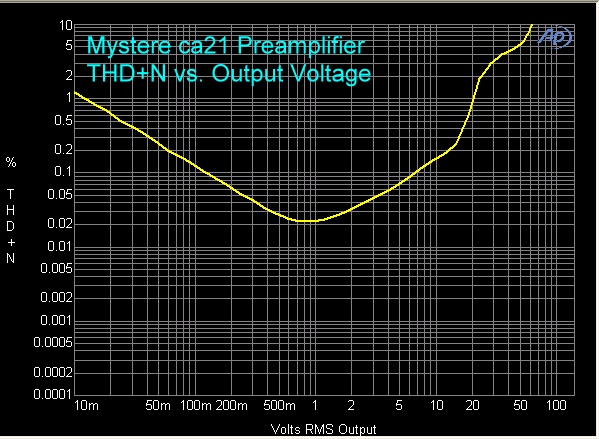
The measured frequency response showed a slight rolloff below 30 Hz, but was only down 2 dB at 200 kHz.
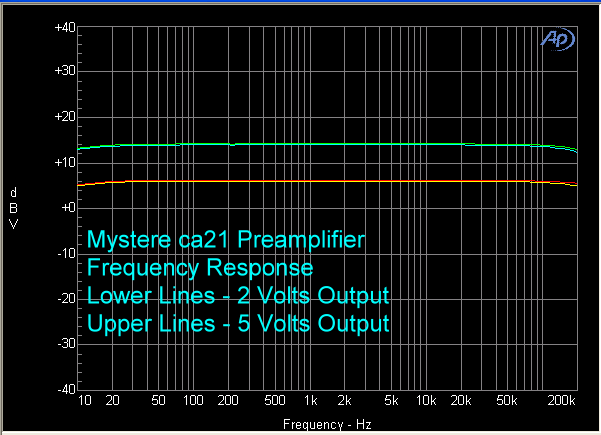
Conclusions
Like its companion, the pa21, the Mystère ca21 is beautiful to look at, solidly built, and delivers the kind of tube sound that a tubeophile will love. Even if purchased together, they won’t break your bank account, although the sweet melodies that they deliver might break your heart.



